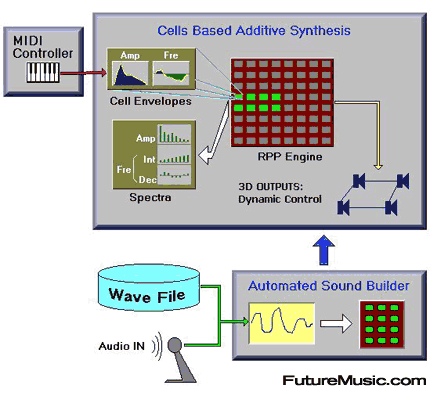Idarca Announces Acxel II – A New Version Of The Original Acxel Synthesizer
Idarca, a Canadian concern, has announced the Acxel II, a new take on the original Acxel from the early 90’s. The new resynth utilizes a dynamic architecture parallel processor, patented by Idarca, the RPP. Taking advantage of the RPP, IDARCA aims to introduce a new take on multisynthesis and the multitimbral Modular synthesizer.
The Technos Acxel may look similar in operation to a sampler, although its workings were very different and the sound structure is accessible. Where samplers used an A/D converter to convert a continuously-variable analogue signal into digital data, the Axcel worked on the premise that any sound, no matter how harmonically complex, could be broken down into a finite number of sine waves, and that these sine waves could be individually altered to fundamentally change the sound, producing what Technos founder Nil Parent termed re-synthèse. The Acxel was invented by Pierre Guilmette, the operational design was Nil Parent realization, the system was developed at Technos, company own and directed by Pierre Guilmette, Nil Parent and other partners. The video below gives you an idea how this synthesis system works…
At the heart of the Acxel II system is a parallel dynamically reconfigurable processor, the RPP with signal synthesis embedded capabilities and ultra low granularity parallel calculator. RPP is based on an array of interdependent intelligent elements so called cells. This architecture enables flexibility that is not accessible with standard single or multiple DSP technology available today.
The Acxel II proposes 3 synthesis modes, including 2 standards: Additive Synthesis (including Re-synthesis) and Analog Synthesis. In addition, the Acxel II introduces its native synthesis mode, the so called Acxelink (with Re-synthesis), this synthesis is built from cell elements organized in a dynamic matrix architecture network that offers full open access to the sound internal structure thru a very intuitive user interface. The flexibility of the Acxel II based on specific configurations of the Acxelink synthesis will naturally enable the introduction of new sound creation models with the introduction of new synthesis modes through continuous software development.
The company will debut a Acxel II model with PCI Sound Card connectivity:
• Full multitimbral unit with graphic interface and Synthesis hardware.
• Sound Synthesis
• Sound processing
• Extensive structural MIDI Controls
• Synthesis Modes: Acxelink, Additive Synthesis, Analog Synthesis
Hardware:
• 256 Cells (16 voices)
• 2 signals IN / OUT (24 bit, 48 khz)
• MIDI Interface
• Digital Signal interface
Acxel II will initially be available in 2 versions:
• Acxel II — PCI: Sound Card (PCI) with software PC/MAC a deliverable in 4 to 6 months.
• Acxel II — SAS: Stand Alone System with “preset” use for scenic performances or in Workstation (with PC or MAC) a Deliverable in 8 to 12 months.
Note: A Touch Sensitive Graphic console will be available as an option in less than 12 months.
No official pricing has been announced. More information on the Idarca Acxel II.







